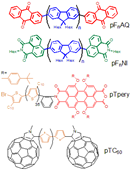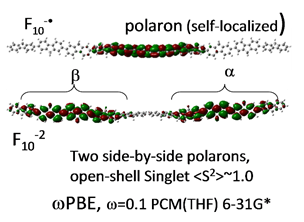- Home
-
Research Groups
Division Groups
- Artificial Photosynthesis
- Catalysis: Reactivity & Structure
- Electrochemical Energy Storage
- Electron- and Photo-Induced Processes for Molecular Energy Conversion
- Neutrino and Nuclear Chemistry
- Surface Electrochemistry and Electrocatalysis
Associated Groups
- Catalysis for Alternative Fuels Production
- Nanostructured Interfaces for Catalysis
- Structure and Dynamics of Applied Nanomaterials
- People
- Operations
- News
- Events

Electron- and Photo-Induced Processes
Molecules for Photovoltaics
This research seeks molecular level understanding of principles that can improve organic photovoltaics (OPV). It seeks to apply principles from electron transfer theories and transient experimental methods with an emphasis on those using electron accelerators (pulse radiolysis) along with excitation by light.
Pulse radiolysis uses ps or ns pulses of high energy electrons to create ionization condensed media. It confers a special, almost unique capability to rapidly inject electrons or holes into conjugated polymers or oligomers, and can even do so in completely non-polar environments. Pulse radiolysis with detection by transient absorption(TA) probes the charged species in the UV-Vis, NIR and IR regions, including the Vis optical fiber single shot (OFSS) ps TA detection system (NIR in development). It also provides one of the best ways to produce and examine triplet excited states.
A new capability is pulse radiolysis transient microwave conductivity (PRTRMC), developed jointly with Garry Rumbles and Obadiah Reid at NREL based on earlier developments at Delft.
Principal questions examined:
- How far and how fast do electrons, holes and excitons (singlet and triplet) transport along conjugated chains? What is the transport mechanism and how does it connect to transport in solid films? Transport is studied using chains having end traps by TA and in those without by PRTRMC.
- Charges in conjugated chains often exist as polarons. What are they like- how long, how compressible? What is the relationship of polarons to bipolarons? How will these properties relate to transport and to Coulomb escape?
- The efficiency of organic photovoltaic devices to convert solar energy into electricity depends critically on avoiding recombination of photo-generated electron-hole pairs. More successful OPV assemblies show high quantum yields for separated electron hole pairs, despite strong Coulomb attraction expected in the low dielectric environment of polymer films. While the quantum yield is high, a major part of the exciting photon energy is lost. What principles can give high yields for Coulomb (Onsager) escape with little loss of energy, and do these relate to questions 1. and 2?
Partial Description of Our Interests
The efficiency of organic photovoltaic devices to convert solar energy into electricity depends critically on avoiding recombination of photo-generated electron-hole pairs. To clarify the factors that determine the yield of separated electrons and holes, experiments are proposed to test the hypothesis that delocalized electrons and holes can escape from each other even in low dielectric constant media such as conjugated polymer films. The experiments will examine how Coulomb binding between electrons and holes is reduced for delocalized charges and the results will be compared to model calculations. The Marcus inverted region provides a known principle to suppress rates of highly-exoergic recombination of electrons and holes. Proposed experiments will examine the hypothesis that this suppression is greater, perhaps much greater, for delocalized species. Such an “enhancement of the inverted region” for reactions of delocalized charges, could further improve yields of escape. Experiments to measure these proposed effects of delocalization will determine lifetimes and escape yields for delocalized exciplexes and for electron-hole pairs on conjugated polymer chains. A delocalized exciplex is a pair of delocalized anions and cations, for example on conjugated oligomers or polymers, in close proximity. Escape along chains will examine charge-transfer states, (D+•,A-•), formed at an electron-accepting group at the end of a conjugated chain. Delocalization of D+• as a polaron in the chain can lead to reduced Coulomb attraction in the pair.
Greater delocalization in nanotubes and in solid films might further enhance escape. The nature of charge delocalization in single-walled carbon nanotubes condensed films of conjugated polymers will be explored by pulse radiolysis microwave conductivity. Advances in three experimental techniques will support the scientific objectives: 1) transient microwave conductivity, 2) infrared transient absorption to detect delocalized charges, and 3) pulse radiolysis of thick (~100 mm) conjugated polymer films.
Many of the experiments will utilize defined molecular structures where definite escape rates and yields can be determined and compared with calculations of Coulomb potentials and electron transfer theory. These model systems in solution, where the environment, especially the dielectric constant can be controlled, will enable exploration of principles controlling charge escape and their potentials for use in converting solar energy.
Once electrons and holes have escaped their mutual Coulomb field transport of both charges is essential for energy storage, and principles that improve transport may sometimes promote escape, so hole and electron transport is another important interest. Closely related is transport of both singlet and triplet excitons.

Conjugated polymers with end trap groups used for investigation of transport of charges and excitons.

One electrons in an oligomer of 10 fluorene units, (F10) forms a
negative polaron that spreads out over 4.5
Two electrons in an F10 oligomer form two side-by-side polarons that
avoid each other.





